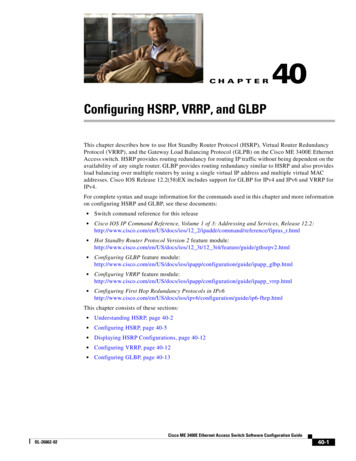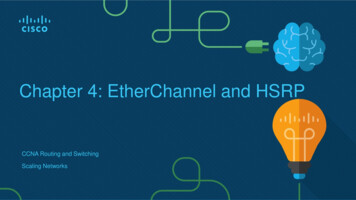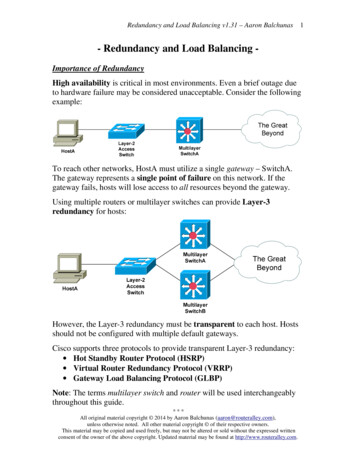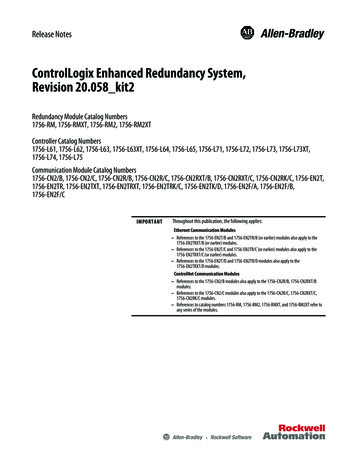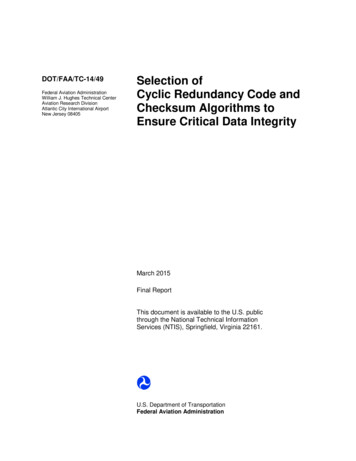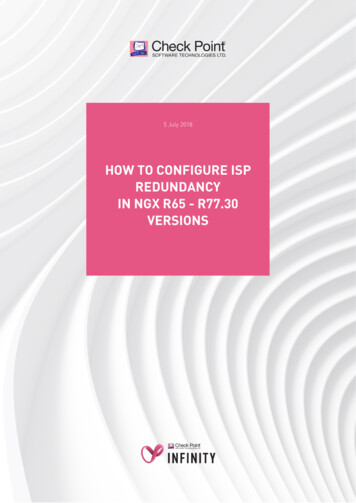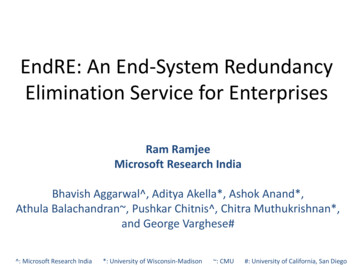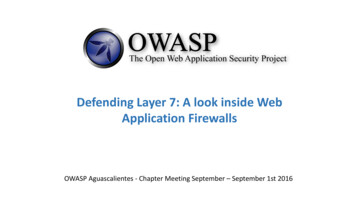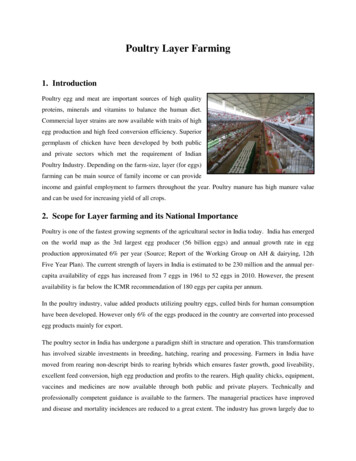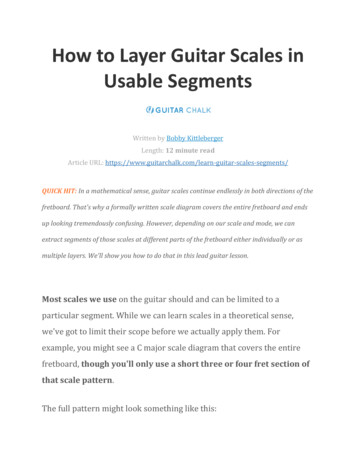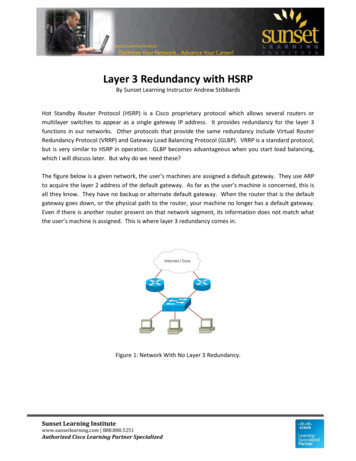
Transcription
Layer 3 Redundancy with HSRPBy Sunset Learning Instructor Andrew StibbardsHot Standby Router Protocol (HSRP) is a Cisco proprietary protocol which allows several routers ormultilayer switches to appear as a single gateway IP address. It provides redundancy for the layer 3functions in our networks. Other protocols that provide the same redundancy include Virtual RouterRedundancy Protocol (VRRP) and Gateway Load Balancing Protocol (GLBP). VRRP is a standard protocol,but is very similar to HSRP in operation. GLBP becomes advantageous when you start load balancing,which I will discuss later. But why do we need these?The figure below is a given network, the user’s machines are assigned a default gateway. They use ARPto acquire the layer 2 address of the default gateway. As far as the user’s machine is concerned, this isall they know. They have no backup or alternate default gateway. When the router that is the defaultgateway goes down, or the physical path to the router, your machine no longer has a default gateway.Even if there is another router present on that network segment, its information does not match whatthe user’s machine is assigned. This is where layer 3 redundancy comes in.Figure 1: Network With No Layer 3 Redundancy.Sunset Learning Institutewww.sunsetlearning.com 888.888.5251Authorized Cisco Learning Partner Specialized
HSRP Function OverviewHSRP groups multiple physical routers or multilayer switches into a single virtual router. All of therouters participating in the HSRP group share a single virtual IP address and a single virtual MAC address.This is what is advertised into our networks. So when a router goes down or the link into the routerfails, there is a second physical device ready to respond to the same default gateway addressinformation. From the user’s perspective, there is no loss in connectivity. From an administrator’sperspective, this means they can focus on fixing the problem without fielding tickets from userscomplaining about network loss.Figure 2: Network With Layer 3 Redundancy.Internal MechanicsWithin HSRP there is a concept of an active router and a standby router. The active router is responsiblefor responding to ARP requests and handling packet forwarding. It is also sending hello messages viamulticast every 3 seconds to the standby router. HSRP uses multicast address 224.0.0.2 or 224.0.0.102,for versions one and two respectively. The standby router does not take any action except to listen forthe hello messages from the active router. The default hold timer (how long it will wait after missinghello packets) is 10 seconds. So if a standby router misses 3 hello intervals, it will assume the activestatus, and begin using the virtual IP address and MAC address. Because these are the exact sameaddresses that the previous active router was using, there is no need to reconfigure the user’s machines.The virtual IP address is chosen by the administrator, and the MAC address is auto generated. Forversion 1, a MAC address of 0000.0c07.acXX is used, where XX is the group number in hex format.Version 2 uses MAC address 0000.0c9f.fXXX, with the last 3 digits again representing group number inhex format.Sunset Learning Institutewww.sunsetlearning.com 888.888.5251Authorized Cisco Learning Partner Specialized
Interface TrackingAnother fun thing you can do with HSRP is interface tracking. Even if your active router is operational,and the user’s traffic can reach the router, what happens if the active router’s upstream connectiongoes down? This could be a link to the internet, or a link to your network core, like in the figure above.If you are running a dynamic routing protocol, it should be able to redirect your traffic to another routerthat has a good upstream link. But what if we could skip the redirection, and just have all trafficimmediately start using the second router as the default gateway? By using interface tracking, HSRPdecrements a router’s priority if an interface goes down. A router with a higher priority in a HSRP groupwill assume the active role. When the interface comes back up, HSRP will resume its original prioritylevel. Using this we can keep our network operating at best possible speed at all time.Load BalancingThe last thing I want to talk about with HSRP is load balancing. Using multiple HSRP groups for multiplesubnets, you can have both routers be active for different subnets, and passive for the subnets the otherrouter is active for. By influencing this decision, you are able to utilize all available resource, while stillproviding the redundancy we wanted in the first place. In the case of a router or link failure, normalHSRP operation will have the remaining router assume the active role for all subnets. But when theproblem is resolved, the routers will resume load balance operations. GLBP does this for us without theadministrative burden of creating multiple groups.Configuring HSRPNow the fun part. How do you configure HSRP? The first step is to determine where on your networkyou want to implement HSRP, specifically the interfaces of your routers. Make sure they are both facingthe same network segment you are providing redundancy for, otherwise this will not work. Once youhave determined which interfaces will participate, add the interfaces into the HSRP group and assign thevirtual IP address they will use. Verify the interfaces are operational, and then verify your HSRP group.Below are the commands and a sample configuration for this process.Sunset Learning Institutewww.sunsetlearning.com 888.888.5251Authorized Cisco Learning Partner Specialized
Configuration CommandsStep 1: Enter global configuration mode: configure terminalStep 2: Enter interface configuration mode, specifically the interface you want to enable HSRP on:interface interface-idStep 3: (Optional) Set the HSRP version to be used (default is version 1): standby version {1 2}Step 4: Create a HSRP group number (0-255, default is 0) the interface will associate with, and set thevirtual IP address: standby [group-number] ip [ip-address]Step 5: End configuration mode and return to privileged EXEC mode: endStep 6: Verify the configuration: show standby [interface-id [group]]Step 7: Save your work: copy running-configuration startup-configurationSample Configuration:Router# configure terminalRouter(config)# interface gigabitethernet 0/0Router(config-if)# standby version 2Router(config-if)# standby 1 ip 10.1.1.1Router(config-if)# endRouter# show standbyRouter# copy running-configuration startup-configurationOnce you have verified the configuration on one router, you will then configure the second router in theHSRP group with the exact same group number. Verify your configuration with the “show standby”command. You should see both routers aware of each other in the group, with one listed as active andthe over as standby. In order for HSRP to work, both interfaces added into the process must be usingthe same HSRP version, the same group number, and the same IP address. If any of that informationdoes not match, they will not act as a group. And please verify before you save over the existingstartup-configuration. It does not help to save a faulty configuration.Sunset Learning Institutewww.sunsetlearning.com 888.888.5251Authorized Cisco Learning Partner Specialized
Other TechnologiesIn addition to HSRP, we have VRRP and GLBP, which I mentioned earlier. VRRP is a standard protocol,while HSRP is a Cisco proprietary. You can use either on a Cisco router, and in function they provide thesame service. One of the major differences between the two protocols is that in VRRP, you can use thephysical interface IP address as the virtual IP address for the VRRP group. If conserving IP addresses is aconcern VRRP will be better suited for your network. GLBP is another Cisco proprietary protocol. Itsmajor advantage is its ability to automatically support load-balancing of multiple uplinks. HSRP andVRRP only have one router active at any time, per group. In order to take advantage of all links at alltimes, you have to configure multiple groups. In a GLBP group the devices automatically share frameforwarding duties. It also provides full redundancy in case of a line or device failure, like HSRP andVRRP.SummaryIn summary, HSRP provides layer 3 redundancy in our network through active and standby routerassignment, interface tracking, and load balancing. A group of physical routers, acting as a single virtualrouter, advertise a single IP address and MAC address into our network. By tracking interfaces andmanaging multiple groups, we can optimize speed as well as add redundancy to our networks. And wecan use VRRP or GLBP based on our individual network needs. The services that HSRP provides are agreat addition to any network.Sunset Learning Institutewww.sunsetlearning.com 888.888.5251Authorized Cisco Learning Partner Specialized
Redundancy Protocol (VRRP) and Gateway Load Balancing Protocol (GLBP). VRRP is a standard protocol, but is very similar to HSRP in operation. GLBP becomes advantageous when you start load balancing, which I will discuss later. But why do we need these? The figure below is a given net
